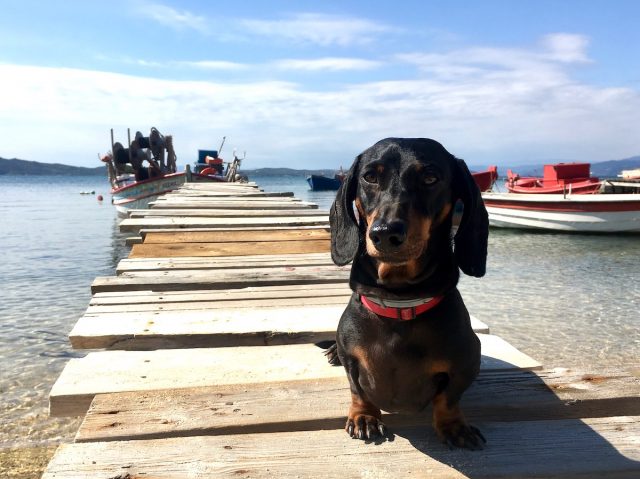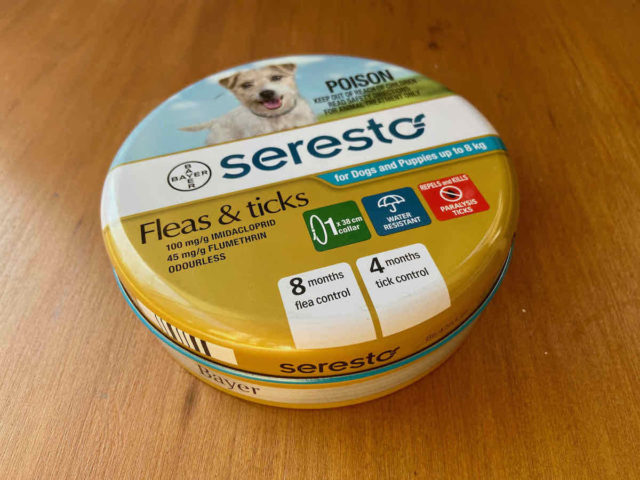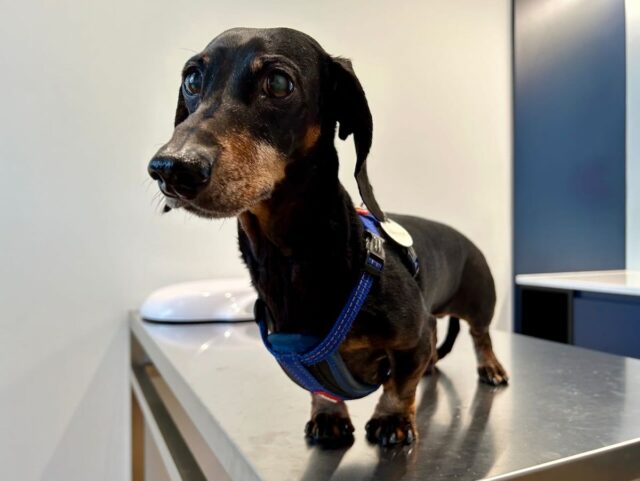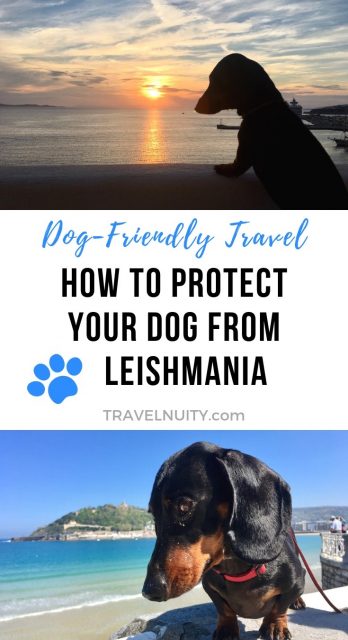Summertime and the months either side are the most popular time of year to head to Europe, including if you’re travelling with your dog. But did you realise that you need to be wary of the disease known as Leishmaniasis across most of southern Europe? Read on to find out more about this disease and the precautions you should take to protect your dog.

What is Leishmaniasis?
Leishmaniasis is an infection spread by female sandflies. The primary hosts of the disease are dogs. If your dog is bitten by a female sandfly that has been infected with Leishmania parasites by biting an infected dog, your dog may also become infected with Leishmaniasis.
Following infection, one of three things may occur. The dog may clear the infection, the infection may develop sub-clinically (with the Leishmania parasite being harboured for a number of months of years before signs occur), or the dog may develop signs of the disease.
Signs of Leishmaniasis
The signs of Leishmaniasis can be quite varied, including skin lesions, hair-loss, intermittent lameness, weight-loss, anaemia, fever and lethargy. In the most severe cases, organs like the liver, kidneys and bone marrow can be affected.
Once a dog develops an active infection, cure is not possible, but rather long-term medication and monitoring is required, to prevent it from becoming fatal in severe cases.
Which Parts of Europe Are Affected?
Leishmaniasis is prevalent across southern Europe including the following:
- Greece (one of the highest levels of incident)
- Spain
- Portugal
- Southern France, including Corsica
- Most of Italy (except the far north)
- Malta
- The Balkans (coastal Slovenia, coastal Croatia, Bosnia, Montenegro, southern Serbia, Northern Macedonia, Albania, Bulgaria)

Leishmaniasis in dogs is also found in many other warmer parts of the world, including northern Africa and the southern USA. There are also other strains that can affect humans, but these are only found in the developing world.
What Time of Year is Leishmaniasis a Risk?
For Leishmaniasis to be a risk, sandflies need to be present, which doesn’t occur year round. In southern Europe, the risk period is from May to September. If there has been a warm summer, the period may extend into October.
To determine if there is a risk of leishmaniasis, take note of whether sandflies are around, in particular during their active period from sunset to sunrise.
Steps to Prevent Leishmaniasis in Your Dog
There are a number of options available for the prevention of Leishmaniasis in your dog.
The main way you can protect your dog is by keeping them inside from dusk to dawn, the period of day when sandflies are active. In particular, avoid wooded and garden areas from dusk where you notice sandflies are present.
Your dog should also sleep inside, not outside. Plus, netting should be present on doors or windows left open, or else they should be shut, to prevent sandflies from coming inside.

Using Collars and Spot-On Treatments
You should also use an insect deterrent for your dog. One of the most popular methods is a collar, such as the Seresto (or Foresto) collar from Bayer or the Scalibor collar from Merck.
These collars are also used for flea and tick prevention, and an advantage is they are effective for multiple months, potentially the entire risk season. However, note that there have been reports of some dogs having allergic reactions to Scalibor collars – monitor your dog after they start wearing one.

Alternatively, use a strong spot-on flea and tick treatment, such as Advantix.
Vaccinations for Leishmaniasis
The other option is to use a vaccination for Leishmaniasis. The Canileash vaccine is used in Europe. It strengths the dog’s immune response and reduces the likelihood of symptoms appearing, although it doesn’t prevent an actual infection.
Dogs require three injections given at three-weekly intervals from the age of six months, plus a single annual booster. Steps to prevent insect bites (such as a collar of spot-on treatment) should still be used in conjunction with the vaccine.
Ideally, see your vet and ask for their guidance, as the latest recommendations can change as new knowledge and techniques are developed.

A Note For Dogs Travelling to Australia
If you’re travelling with a dog from Australia and intend to return to Australia, or if you intend to take your dog to Australia in the future, you need to be particularly careful of Leishmaniasis.
Dogs travelling to Australia require multiple blood tests to show they are free from certain diseases not present in Australia, including Leishmaniasis. If your dog tests positive for the Leishmania parasite (Leishmania infantum) (even if they do not show symptoms), you probably will not be able to take your dog to Australia.

This was the case for us, so I was extra vigilant with preventing my dog from being exposed to Leishmaniasis, while travelling to Bulgaria and Greece in late summer. My dog was already using Advantix for fleas and ticks, but after speaking to a vet in Bucharest, we additionally got a Seresto collar, for 99% effectiveness.
We skipped getting the vaccine, as getting three shots was tricky with us travelling around, plus it doesn’t prevent the initial infection.
A couple of months later in the US when we had our dog tested for the Leishmania parasite, I was very relieved when we received the negative result!
You May Also Like
- Travelling in Europe with a Dog
- Do You Need a Dog Muzzle When Travelling in Europe?
- How to Keep Your Dog Safe While Travelling in Australia
About the Author

Shandos Cleaver is the founder of Travelnuity: Dog-Friendly Travel. She has travelled extensively with her Miniature Dachshund, Schnitzel, including to 33 countries across Europe, every state and territory of Australia except Tasmania, and 10 of the United States. She’s passionate about providing inspiration and information to others wanting to travel with their dogs, whether close to home or internationally.
Pin this to your Pinterest board!


Great information thank you for doing the research and for sharing!
Happy to share, Bee! It’s important to keep our dogs safe.
Hello, Please double check Seresto – I am pretty sure it does not contain premethrin (?) and does not protect against Leishmaniasis. Only Scalibor does… If i remember correctly, Scalibor covers for a longer time than the spot on (Advantix, Effitix)..
Safe travels!
Our dog was wearing Scalibor in Spain and still got bitten by sandfly. It was in the sleeping mode for 2 years until another dog bite him. Leishmaniasis was activated and in 11 months after the dog bite our baby died with horrible lesions and bleeding 😭😭😭
That’s so terrible to hear Natalie, it’s a horrible disease. Unfortunately the collars aren’t always 100% effective, just like many vaccines for humans, but I always recommend using a collar or other treatment and taking other steps to minimise the risk.
Our rescue from spain postive for leishmaniasis. I had never heard of it before. She is now on medicstion which we hope will get it under control, although it is chronic with right medicstion it can help the dog lead normal life
I hope your pup recovers xx
Ooops – sorry, I double checked and Seresto now also protects against Leishmaniasis! I was wrong, and not up to date, thanks for enlightening me!
Yay!
That’s great to hear! Thanks for checking 🙂
Hi there great item . We are travelling with our dog to Mallorca next year will be living there from April till September.
He will be fully vaccinated etc including rabies wondered if it’s worth getting leishmaniasis or just using the Scalibor collar .
I’d lean towards getting the leishmaniasis vaccine as well. At the least, speak to your vet, and see what they say.
is there anyone aware about a natural manner to protect the dog against this disease? I´ using, for my dog, coconut oil against other parasites ant it´s working good. unfortunately coconut oil is not efficient to prevent mosquitos bites.
I’d mainly rely on keeping your dog inside when sandflies are around, especially in the evening and overnight.
I have used Scalibur for my dog when in Italy. However, the second time we used it (the following year) she has been having fits and was having trouble breathing. We removed the collar but for an extra day she has had the symptoms.
Daniela – Thanks for sharing.
My little Yorky cross was the same Daniela. Within 8hours of wearing the Scalibar collar she started jerking and twitching and crying. I removed the collar and the symptoms persisted for another 36 hours. We are going to Loire Indre France and hoping there are not so many risks
I believe that now the dog usually requires a negative test result before the vaccination can be done? In Italy, at least
The vaccine is still fairly new, so the process may vary for different countries. But I’m not surprised that a negative test result may be required.